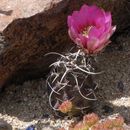en
names in breadcrumbs


Echinocereus fendleri has an indefinite number of (mostly) unnamed geographic races. One of these, var. rectispinus, of southeastern Arizona has enjoyed undeserved emphasis in the literature; it is often based on misidentifications of tetraploid E. fasciculatus.
The tuberculate stems and sparse, strangely modified spines of immature plants are retained to some extent in adulthood in some populations of Echinocereus fendleri var. fendleri. Such plants superficially resemble Pediocactus peeblesianaus. The name E. fendleri var. kuenzleri (Castetter, P. Pierce & K. H. Schwerin) L. D. Benson and its Mexican counterpart, E. hempelii Fobe, are based mainly on the stem feature. Immature plants of all populations share that distinctive appearance, strikingly different from immature plants of similar or related species, such as E. fasciculatus. In adulthood this convenient diagnostic characteristic is usually lost, rendering identification more difficult. On the Mexican border immature plants in some populations have as few as four spines per areole; they probably are intermediates with the obviously conspecific Chihuahuan taxon, E. hempelii Fobe.